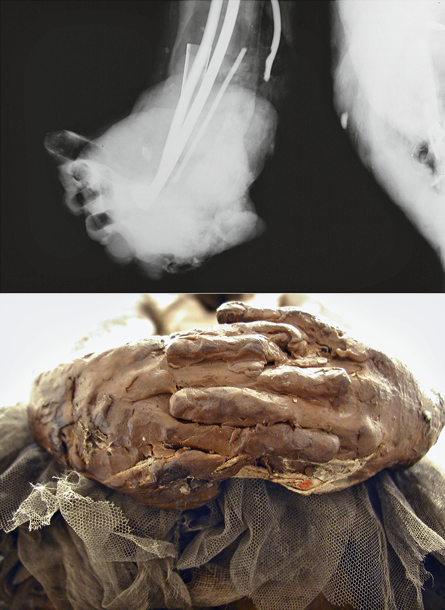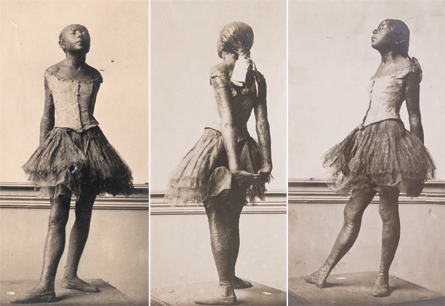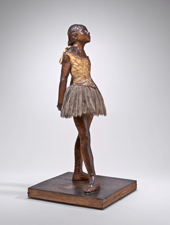
Figs. 1–2
left: Degas, Little Dancer Aged Fourteen, radiograph, overall frontal view
right: Schematic diagram of the internal armature of Little Dancer Aged Fourteen. Illustration by Julia Sybalsky and Abigail Mack, 2007
Radiography (fig. 1) reveals that the sculpture is fashioned over a central armature whose construction closely resembles the small sketch noted in figure 2. Identified using XRF as lead, [1] the central armature consists of intersecting hollow pipes approximately 0.5 inch in diameter. It is of interest to note that Degas incorporated somewhat standard armature materials and configuration to make this masterpiece, choosing “lead pipes ½ ″ and 1″ diameter,” an item listed among those Auguste Rodin’s student Malvina Hoffman prescribed as necessary in a sculptor’s studio for fabricating armatures.[2]
One pipe provides a vertical central support that attaches to an inverted U-shaped pipe at the groin, each side of the U extending downward into a leg. Inside the legs, most notably in the right, the pipes were bent to accommodate the pose of the dancer. As observed in the radiograph of the left foot, the pipe was secured by screws into an oblong metal plate on the base. That of the right leg was wrapped using wire to provide texture to the surface so that a clay core could be built up over it. A small sample of the core from the top of the right leg, examined using PLM and SEM, was identified as a water-based air-dried clay (ferruginous aluminosilicate clay), henceforth in this entry referred to as clay.[3]
The complex construction of the figure, emanating from the vertical rod in the body, is repeated at slight variances in the limbs, neck, and head. It can be loosely characterized as often containing an internal organic bulking element bound to an armature, over which clay and ultimately wax are added. In the torso, this internal mass appears to have been roughed out in two stages. The innermost portion consists primarily of pieces of wood held to the central armature with tightly twisted wire. [4] Over this a second layer of organic matter (similar in density to cotton batting) is bound with rope from the groin to just above the waist (fig. 2). A visual aid useful for interpreting the rope-bound core of the torso can be seen in the comparison of the rope core of the fingers and their radiograph (fig. 3).

Fig. 3: Detail, radiograph (above) and photograph (below) of Little Dancer Aged Fourteen, showing internal fabrication of the hands
The internal construction also served to rough out the ultimate contour of the dancer’s abdomen. Degas added a layer of padding, anticipating the protruding belly of the adolescent girl over both inner core bundles. Unlike the construction of a period doll, to which the sculpture has been relentlessly compared and whose torso cavity would have consisted merely of stuffing hidden under garments, the fabrication of Little Dancer contains a clay layer over the entire bundle that is then clad in wax. [5] Degas’s use of this technique emphasizes that his process involved modeling a complete figure, primarily working from the inside out and from the feet up except for the arms, which appear to have been attached separately.
Construction of the legs, because they are weight bearing and need to be stable, is slightly different. Clay added directly to the armature pipe from the feet to the knees permanently fixed the position, stabilized the armature, and facilitated modeling.[6] Only at the knees was the inner portion of the clay replaced by a bundle of organic material wrapped with the same gauge wire used around the pipe in the right leg and bound with rope.[7]
Above the section of the torso wrapped in rope, there is a short metal rod perpendicular to the central vertical pipe, of slightly smaller diameter, that extends across the dancer’s chest. Because the rod is inserted between wooden batons through the organic bundle and is incorporated into the wrapping wires, it is likely part of the earliest stage of construction. Degas probably added it to provide support for the separately attached arms. However, in forming them, he deviated from the traditional technique of tying pipes to the central framework to support the appendages. Instead, he added a pair of double strands of loosely twisted iron [8] wire that extend from the right elbow and across the chest but stop abruptly at the left bicep. These wires define a shape or placement but do not provide true support for the arms since they are not tied to the central pipe and may have cracked or broken. When the same area is compared to the photographs for the 1917 – 1918 inventory (figs. 4 –6) and the photographs from the Mellon collection records, possibly sent by Knoedler Gallery to Paul Mellon through the National Gallery of Art at the time of the sale (figs. 7, 8), it is evident that a prominent crack was present in the upper left arm that was subsequently repaired. While it is not possible to corroborate the art historian Paul Lafond’s observation that at the time of Degas’s death Little Dancer’s “arms were broken off from the body and lying pitifully at its feet,” [9] the extant condition of the armature and the surface condition of the wax suggest that portions of the arms could have been broken or even detached from the dancer.

Figs. 4 – 6: Little Dancer Aged Fourteen, photographed by Gauthier for the 1917-1918 Durand-Ruel inventory, front, rear, and three-quarter view. Musée d’Orsay Paris. Photo © RMN-Grand Palais / Art Resource, NY. Photographer: Franck Raux

Figs. 7 – 8 Little Dancer Aged Fourteen, photographs, late 1955 or early 1956, front and rear view. Mellon collection records, National Gallery of Art curatorial files, Washington
Once satisfied with their positioning, Degas modeled the arms in wax over the wires. Inside, he reinforced the wire armature using a wooden framework, as recommended in sculpture manuals [10] but translated into his own manner by incorporating paintbrushes [11] that run the length of each arm, evident in the radiograph by their slender, tapered handles and metal ferrules, and included in the schematic diagram (see fig. 2). C-shaped wires that secure both arms below the shoulders are evident on the radiograph (see fig. 1). Aware that the dancer’s arms were not adequately supported, Degas may have added the wires, or they may have been introduced posthumously to reinforce areas where cracks existed.

Fig. 9: Degas, Little Dancer Aged Fourteen, detail of radiograph, showing head in profile
Moving from the construction of the arms into the head, one sees from the radiograph (fig. 9) that the familiar technique of the wire-wrapped organic bundle, used for the legs and torso, was also employed to form the inner core of the neck and head.[12] On the left side, a wooden baton incorporated within the wires extends beyond the central lead pipe; on the right, a spring of galvanized iron[13] hooked into the wires lengthens the internal support. Surrounding the upper end of the lead pipe, the core bundle continues into the head and neck, providing an inner framework almost entirely at the back of the head. Several layers of clay and wax were then applied to enlarge and define the face and top of the head. A small sample of clay taken from the interior at the nape of the neck, analyzed using SEM-EDS, was identified as the same clay found in the right leg.[14]
Notes
1. The lead pipe is close to the surface at the back of the dancer’s left ankle. See Barbara H. Berrie, Analysis Report, January 21, 2005, NGA conservation files.
2. Malvina Hoffman, Sculpture Inside and Out (New York, 1939), 107.
3. Michael Palmer, Analysis Report, March 29, April 17, 2002, NGA conservation files.
4. The construction is similar to what E. Roscoe Mullins, A Primer of Sculpture (London, 1890), 30, describes, recommending thus for the inner framework: “If the work is a large one, attach at intervals small pieces of wood to the piping in the arms and legs to prevent the clay from slipping.”
5. For a discussion of wax dolls, see Mary Hillier, The History of Wax Dolls (Cumberland, MD, 1985), 19 – 40. That the construction of Little Dancer is inconsistent with that of a contemporaneous doll is significant. Little Dancer has been compared to wax dolls or puppets since it was first exhibited. See, for example, Richard Kendall, Degas and the Little Dancer, exh. cat. (New Haven and London, 1998), 55 – 64.
6. The clay surrounding the lead pipes in the feet and lower legs served to “cement” the armature in place and prevent any movement or change to Little Dancer’s pose. It is also likely that an additional external support held the pipes in place. Once a sufficient portion of the figure had been constructed and the sculpture could support itself, the external support armature would have been removed.
7. The wire in the thighs is not a continuous single strand but rather a series of individual pieces. Both a rope and the wire secured the organic material around the pipe.
8. Barbara H. Berrie, Analysis Report, January 21, 2005, NGA conservation files.
9. Paul Lafond, Degas, vol. 2 (Paris, 1919), 66: “ses bras se sont détachés du tronc et gisent lamentablement à ses pieds.”
10. See, for example, Mullins, Primer for Sculpture, 30.
11. Paintbrushes like these were found in Degas’s studio after his death and are today, with other effects from his studio, in the collection of the Musée d’Orsay, Paris.
12. There is no evidence in the construction of the head to suggest that it was ever severed. Louisine Havemeyer’s April 1920 letter (probably to Mary Cassatt, Archives Durand-Ruel, Paris), in which she writes, “A-t-on remis la tête sur le corps de la Danseuse?” (Has the head been put back on the body of the Dancer?) may be more tongue-in-cheek than documentary. See Anne Pingeot, Degas: Sculptures (Paris, 1991), cat. 73.
13. Barbara H. Berrie, Analysis Report, January 21, 2005, NGA conservation files.
14. Michael Palmer, Analysis Report, March 29, April 17, 2002, NGA conservation files.





